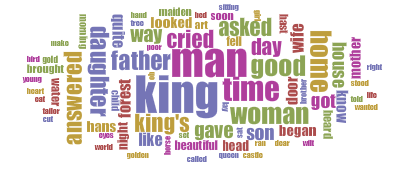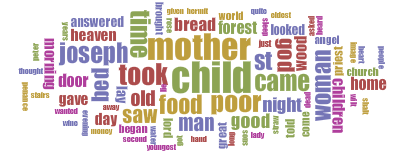Introduction
Jacob & Wilheim Grimm, better known as the Brothers Grimm, had a massive impact on the literary world and how we view literature. Looking at the stories we all grew up with as children and the stories that continue to prevail it is clear that the brothers had a sizeable influence over what we are exposed to and even more noticeable now as we have entered a period where it seems that a movie version of every known fairy tale must be made. The Grimms were German academics, linguists and of course authors. Between the years of 1812 and 1815 they published two volumes of German folk tales. In the years that followed, until 1857, they published a further five editions of this collection. Eventually the brothers were happy with the structure, content and sequence of the collection. In culmination the body of work contained 201 folktales and 10 children’s legends and was entitled Kinder- und Hausmärchen – Children’s and Household Tales. I believe this body of work has a lot of potential for academic study purely based on the structure of the work. Through the course of this essay I am going to look at a couple of topics pertaining to the Children’s and Household Tales collection. Firstly I am going to look at the structural difference between the 201 folk tales and the 10 folk legends. I will then look at gender weighting between the two groupings and finally discuss religious imagery taking in to consideration my previous points. There is a natural break between the folk tales and the folk legends therefore I will the folk tales independently followed by an independent study of the folk legends and finally a collaborative study of both. I will repeat this method for my analysis of structure, gender and religion respectively.
Methodology
To achieve detailed and accurate results from this study I used a number of tools to support my opinions on structure, gender and religion. These were:
- The software package R and R Studio (Eder et al., 2013).
- Voyant Tools.
R is a software package that caters for statistical computing and graphics. Voyant is a web-based reading and analysis environment for digital texts (Voyant). I used R to assess the structure of the pieces and will go on to use Voyant to assess gender weighting and religion within each respective group.
Structure
To begin the study I analysed the folk tales using R. The cluster analysis operates on a method whereby it identifies the 100 most frequent words in a text and clusters texts together by similarity in shared words. The initial cluster analysis I ran was of the 201 folk tales to see which tales clustered together. I did not expect to find anything of significance and indeed I did not. These are the results of the initial cluster analysis of solely folk tales.
If I was completing more in depth study of individual folk tales from the collection then the above data would prove useful however I am more concerned with the comparative study between folk tales and folk legends.
Following this I completed a similar cluster analysis on the folk legends. Once again the results were nothing surprising however I noticed that there was a slight divide causing two groups to form. The first group included legends 6,1,4,2 and 9 and the second group included legends 7, 3,10,5 and 8. I did not understand the significance of this divide until further in my study. These are the results of the cluster analysis of the folk legends.
To complete my cluster analysis study of the body of work, I performed a cluster analysis on the entire collection. Below you can see the folk tales in red and the folk legends.
Once again nothing stood out from this cluster analysis. After this result I performed a closer reading of the tales that the legends were clustering towards. What I found was the legends in the lower third of the graph clustered towards tales that contained religious imagery while the legends higher up on the graph freely associated with tales that contained strong magical content. From this point I knew that a more in depth study was needed to identify the difference between folk legends and folk tales as it was clear there was something there.
I then ran the same process but this time utilising a bootstrap consensus instead of a cluster analysis. The bootstrap consensus is a more precise measurement of literature analysis as in takes in to consideration the 1000 most frequent words. I ran a bootstrap consensus on the folk tales with nothing of interest for this particular study. After that I ran a bootstrap consensus of the folk legends and found the following.
My suspicion of the divide was proven correct after a more detailed bootstrap consensus. Once again after a close reading of the legends I found that the use of religious imagery was more prominent in the lower grouping with the higher grouping containing less religious connotations but by comparison to the folk tales contained much more religious content. From this point I ran a bootstrap consensus of the entire collection to view the structural difference between the legends and the tales. These were my findings:
Above the graph shows the legends in green and the tales in red. My suspicions were confirmed. There is a clear divide between the legends and the folk tales ensuring the structure and general language used in either are very different.
Interpretation of structural results:
It is evident from the combined graphs after running a more comprehensive analysis of the texts that there is a clear divide between the folk legends and the folk tales. This is due to a number of reasons. The legends are religious in content whilst the folk tales are not. This was identified in the 1000 most common words bootstrap consensus. These findings led me to believe that there may be more concrete reasons for the divide. I decided to investigate gender and religious conations from this point.
Gender
Using Voyant I decided to investigate gender weighting between folk tales and folk legends. Using the word trend feature I constructed a graph tracking a specific group of words firstly in the folk tales and then I the folk legends. This list contained the words: child, mother, father, woman and man. These were the results from the folk tales.
It is clear there is a more dominant male presence in the folk tales with the words father and in particular man featuring much more than the other words in the graph. To see this data on a visual scale in comparison to the other words in the folk tales I created a word cloud. This is what I found.
It is clear from this word cloud that there is a stronger male presence. The word cloud even showed results which I had not accounted for. For instance the word king features quite heavily, more so than man or father however it is directly male in connotation.
Using the same word list I executed the analysis on the folk legends. This is what I found in the word trend graph:
Here it can be seen that the gender weighting is in direct opposition to that of the folk tales. The words mother but more importantly woman feature more so than any of the male words. This is quite interesting as I suspected a male presence to be more dominant in the folk legends given their religious nature. Once again I constructed a word cloud for the most common words in the folk legends to see if there was any other information I had omitted.
It was clear from this word cloud that nothing of significance had been omitted from the word trend.
Interpretation of Gender Results:
Clearly there is a stronger female presence in the folk legends and a stronger male presence in the folk tales. This may have something to do with the fact that there is a larger body of work in the folk tales and there will be some discrepancies. However it should be noted that after this I ran a word trend comparison using the words woman and God to see their use in the folk legends and found the word woman to occur more than God. This I feel is something that should be investigated further as the religious nature of the folk legends almost dictates that there should be a stronger male presence.
Gender
Finally I looked at religion and gauged the use of two definitive religious words that occurred in both the folk tales and the folk legends: angel and God. The first graph illustrates the amount of times these words are mentioned in the folk tales whilst the second graph illustrates their occurrence in the folk legends.
Comparing these graphs it seems that the rate of each word is not that different. However when taking in to context the size of each body of work the results seem more definitive. The first graph accounts for 201 folk tales showing that God is a prominent feature in some of them, the second graph accounts for 10 folk legends also showing God is a prominent feature in these. It must be noted that the rate of God is higher in the folk legends than the folk tales and given the numerical ‘disadvantage’ the legends hold in their size of work, it shows religion is the centre point for the legends.
Interpretation of Religion:
The findings from my study of religion in the Grimm’s collection proved more valuable than I thought. After I reached these results I went back over the folk tales that featured the word God heavily and found that these were the same folk tales that clustered with the folk legends in my initial cluster analysis of the entire body of work. This accounts for the mixed results I encountered at the start of this research.
Conclusion:
Throughout this research project I have learned quite a few things both in my quantitative study of the Grimm’s collection and closer reading to extract more definite results. In terms of structure it is clear that the legends differ greatly from the folk tales and explains why they have their own section within the Grimm’s collection. With regards to gender weighting I believe I have proved conclusively there is a stronger female presence in the folk legends and a stronger male presence in the folk tales. This may be because the villain is more than usually a stepmother in the folk tales allowing the male characters to be showcased as heroes and celebrated in their gender. Finally the religious balance is clearly stronger in the folk legends than the folk tales. I believe there is much more that can be extracted from this collection however given the time frame I feel this is all I can record at this present moment.
Bibliography
- Eder, Maciej, Mike Kestemont, and Jan Rybicki. “Stylometry with R: A Suite of Tools.”Digital Humanities 2013: Conference Abstracts (2013): 487-89. Assessed on the 16-12-2013
- Voyant (http://voyant-tools.org/) Assessed on the 18-12-2013
- Grimm Brothers Text (http://www.fln.vcu.edu/grimm/grimm_menu.html) Assessed on the 6-12-2013















